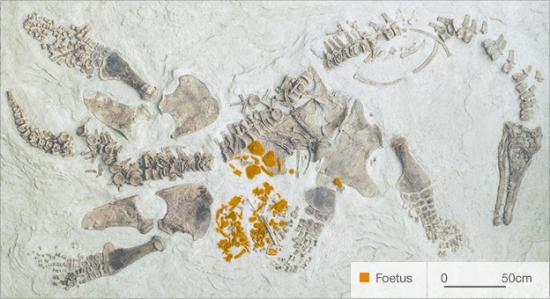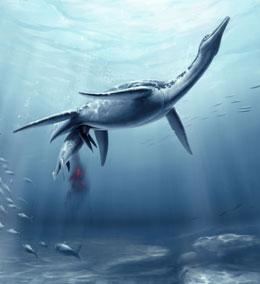摘要:据法新社8月12日报道,美国科学家近日在一具史前蛇颈龙化石体内发现了一具小蛇颈龙的胚胎,首次证实蛇颈龙是胎生动物而非卵生动物。
这具蛇颈龙化石长4.7米,已有7800万年的历史,是1987年在美国堪萨斯州(Kansas)被发现的,目前正在洛杉矶的自然历史博物馆展出。科学家在对化石做进一步研究时意外发现,化石中还隐藏着一具胚胎骨架,小小的肋骨、椎骨、肩骨等清楚可见。
据悉,蛇颈龙看起来有点像蛇和龟的结合体,有四个像蹼一样的脚用于游泳。由于蛇颈龙生活在海洋中,此前科学家依据其体型和习性推测,这种生物不大可能专门登陆上岸产卵,其应该是胎生,但一直没有确切证据,直到这具含有胚胎的化石被发现。
目前这项研究成果已被发表在最新一期的《自然》杂志上。

The fossil of pregnant Polycotylus latippinus was almost complete, missing only its head and neck
生物探索推荐《自然》杂志原文
Did reptile swimmer show mother love?
A single large baby suggests that plesiosaurs cared for their young.
A fossil of a plesiosaur, an extinct marine reptile, has revealed that not only did these animals give birth to live young, they may also have cared for their offspring in a manner similar to today's whales and dolphins.
The 78-million-year-old fossil, of a four-flippered giant belonging to the species Polycotylus latippinus, had lain unexamined in a museum basement for nearly 25 years.

Plesiosaurs gave birth to live young, and may have lived in groups.
Other extinct marine reptiles, such as ichthyosaurs, mosasaurs and choristoderans, were known to give birth to live young, a strategy called viviparity. This is the first evidence that plesiosaurs did the same, rather than hatching their offspring from eggs on land.
"We have known about plesiosaurs for almost 200 years, but despite an excellent fossil record we have never found a pregnant plesiosaur before," says palaeontologist Robin O'Keefe at Marshall University in Huntington, West Virginia, who analysed the fossil with Luis Chiappe at the Natural History Museum of Los Angeles County in Los Angeles, California.
Unlike other ancient marine reptiles, which gave birth to many small babies, the Polycotylus fossil shows just one big fetus, 150 cm long, inside a mother 470 cm long. The fetus, which has 20 vertebrae, shoulders, hips and paddle bones visible, is thought to be about two-thirds grown. The finding is published today in Science.
Modern animal mothers that have a few, large offspring, such as humans, elephants, and whales and dolphins, invest a lot in parental care. "If you are going to put all your egg in one basket by having a single large baby, it makes a lot of sense that you would want to take care of that baby," says O'Keefe.
Plesiosaurs probably did the same, he speculates, and may have lived in groups for protection, making their social lives more similar to those of modern marine mammals than to other extinct marine reptiles. The alternative, that the baby would have been born ready to take care of itself, doesn't make sense, he says, because the fetus's unfused bones suggest that it would not have been physically independent at birth.
A few living reptiles, such as some skinks, also give live birth to a small number of large young. They too exhibit mammal-like social behaviour, notes O'Keefe.
On display
The specimen is "spectacular", says Michael Everhart, an expert in prehistoric marine reptiles at the Sternberg Museum of Natural History in Hays, Kansas. "It has answered a question we have had for years," he says.
But Everhart also believes it is premature to conclude that plesiosaurs' social and reproductive lives were dramatically different to those of other extinct marine reptiles. "I would like see a half dozen more specimens first," he says.
A private fossil hunter found the plesiosaur in Kansas in 1987. It was donated to the Natural History Museum of Los Angeles County, where it lay unprepared. "There has always been scuttlebutt about the pregnant plesiosaur fossil in the basement," says O'Keefe.
Last year, it was decided that the fossil should be displayed and the necessary funding for its preparation and display was obtained. The plesiosaur has just gone on view in the museum's new dinosaur hall.
生物探索推荐BBC原文报道:
Fossil 'suggests plesiosaurs did not lay eggs'
Scientists say they have found the first evidence that giant sea reptiles - which lived at the same time as dinosaurs - gave birth to live young rather than laying eggs.
They say a 78 million-year-old fossil of a pregnant plesiosaur suggests they gave birth to single, large young.
Writing in Science, they say this also suggests a degree of parental care.
The fossil, the first of a pregnant plesiosaur found, is at the US's Los Angeles County Natural History.
After being excavated from a ranch in Kansas, US, the 5m-long fossil skeleton Polycotylus latippinus lay for two decades in the basement of the Los Angeles County museum waiting to be chiselled from its rocky casing.
Immature skeleton
Two years ago when researchers began to piece the bones together they quickly realised that they were in fact dealing with two separate animals; an adult plesiosaur and a smaller juvenile.
The study's authors report that the juvenile was unlikely to have been eaten by the larger reptile because its tiny bones showed no evidence of bite marks, and its soft, immature skeleton suggested an animal only two-thirds of the way through its development.
For more than 200 years palaeontologists have speculated about how these colossal cretaceous animals reproduced.
Many believed the plesiosaur was too cumbersome to drag itself up the beach to lay eggs, and so must have given birth to live young.
"[The find] provides the first direct evidence for live birth in plesiosaur," said palaeontologist Adam Smith from the Thinktank Centre, Birmingham Science Museum.
"It's a very interesting find...[and] has been a long time coming."
Doting parents?
"The lack of fossil evidence of a pregnant plesiosaur was frustrating," explained the study's lead author Frank O'Keefe, from Marshall University in Huntington, US.
But he added: "What is really surprising about this fossil [is] that plesiosaur [reproduces] differently to other marine reptiles... they give birth to one big baby instead of a lot of little babies."
By making comparisons with modern animals, such as whales, which give birth to larger, single young and then go on to care for them, Dr O'Keefe and his colleague, Luis Chiappe from the museum, attempt to infer something about plesiosaur behaviour.
In a similar way to land-dwelling dinosaurs, which are thought to have provided food for their nest-bound young, plesiosaurs, the authors suggest, might have been doting parents.
But Dr Smith was less convinced. He said that it was "certainly quite possible... but is very speculative".
P. latippinus's close relatives, the nothosaur-grade sauropterygian, had three young at one time. It is possible the P. latippinus evolved to have only one, and care for it, he told BBC News, but more pregnant specimens are needed to be more certain of this.
Dr O'Keefe agreed, explaining that unlike on land where nests are preserved, studying the behaviour of ancient marine creatures is very difficult.
"When you get right down to it, behaviour doesn't fossilize, so we are stuck trying make these inferences using modern animals where we can observe their behaviour," he explained.
生物探索推荐:







